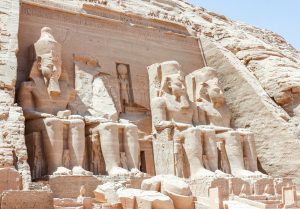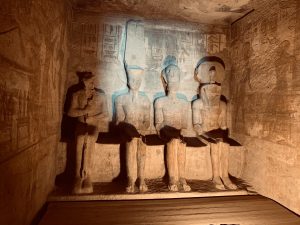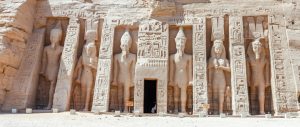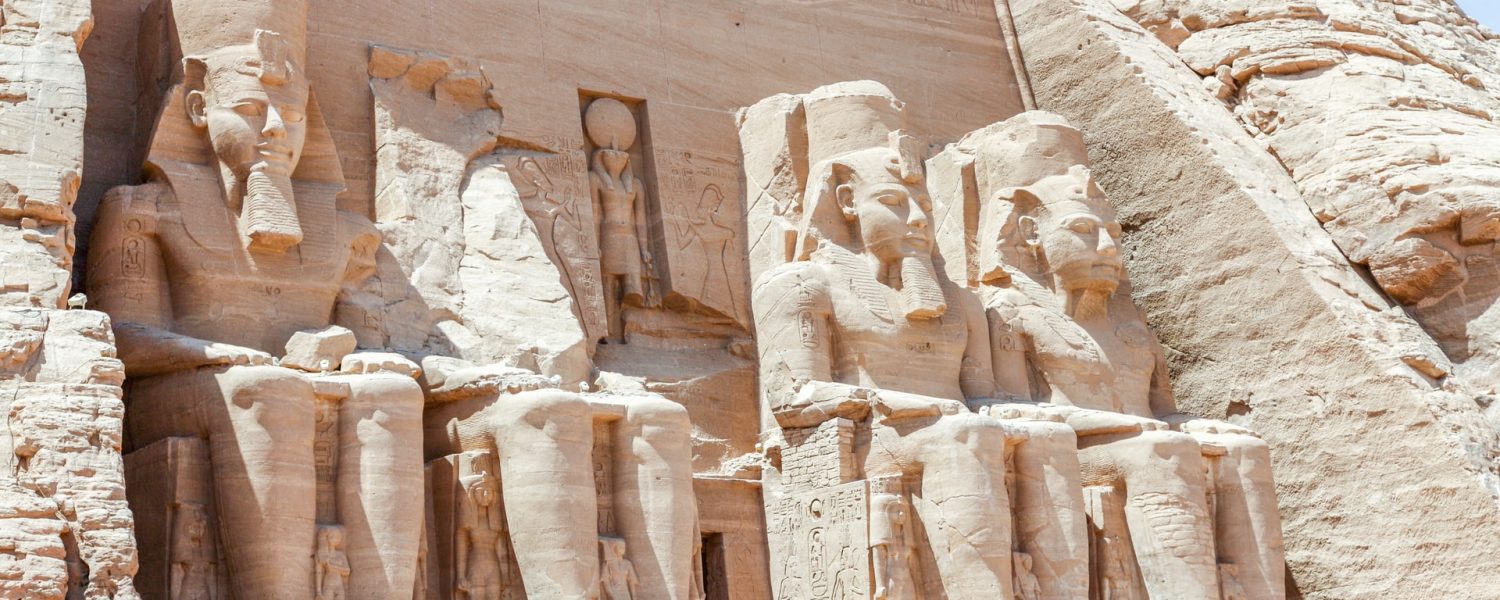Temples of Abu Simbel
Nestled in the arid deserts of southern Egypt, the Temples of Abu Simbel stand as a testament to the grandeur, artistry, and engineering prowess of ancient Egypt. These magnificent temples, hewn from solid rock and dedicated to the Pharaoh Ramesses II and the goddess Hathor, are among the most iconic and awe-inspiring archaeological sites in the world.
Carved into the cliffsides of the western bank of the Nile River, near the border with Sudan, the Temples of Abu Simbel date back to the 13th century BCE during the reign of Ramesses II, one of ancient Egypt’s most celebrated pharaohs. These temples served both religious and political purposes, reflecting the divine might of the pharaoh and the veneration of deities.
Temple of Abu Simbel Egypt
Here’s an overview of the two main temples:
Temple of Ramesses II (The Great Temple)
-
- The larger of the two temples is dedicated to Pharaoh Ramesses II, one of Egypt’s most powerful and long-reigning pharaohs.
- The temple’s façade features four colossal statues of Ramesses II seated on his throne, each standing at approximately 66 feet (20 meters) in height.
- The interior of the temple is adorned with intricate carvings, depicting scenes from Ramesses II’s military conquests and his divine right to rule.
- Notably, the temple is designed so that the sun’s rays penetrate the inner sanctuary twice a year, illuminating the statues of Ra, Amun, and Ramesses II in a stunning celestial alignment on specific dates.
Temple of Hathor and Nefertari (The Small Temple)
-
-
- The smaller temple is dedicated to Hathor, the goddess of love, music, and motherhood, and to Queen Nefertari, Ramesses II’s favorite wife.
- The façade of the temple features statues of the pharaoh and the queen, flanked by images of the deities Hathor and Isis.
- The interior of the temple contains intricately carved scenes depicting the royal couple making offerings to the gods.
- The temple was built in honor of Nefertari and is considered a testament to the love and respect the pharaoh held for his wife.
-
These temples were originally carved into the mountainside during the 13th century BCE and served both as places of worship and to demonstrate the power and authority of the pharaoh. Their relocation was a complex engineering endeavor that involved cutting the temples into massive blocks, moving them to higher ground, and reassembling them, all while preserving their historical and architectural integrity.
The Temples of Abu Simbel remain a popular tourist destination and are recognized as a UNESCO World Heritage Site, offering visitors a glimpse into ancient Egyptian civilization and the incredible feats of both the past and modern eras. They are an enduring testament to the grandeur of Egypt’s history and the dedication to preserving its heritage.
All Information about the Great Temple of Ramesses II at Abu Simbel

The Great Temple of Ramesses II, situated in Abu Simbel, is an architectural marvel and a testament to the might and ego of one of ancient Egypt’s most powerful pharaohs, Ramesses II. This temple, dedicated to the pharaoh himself, is one of the most iconic and grand structures in the country. Carved into the mountainside, it is renowned for its colossal statues, intricate reliefs, and celestial alignments that occur on specific dates. Here are all the details about the Great Temple of Abu Simbel:
1. Construction and Purpose:
- The temple was built during the 13th century BCE during the reign of Pharaoh Ramesses II, also known as Ramesses the Great.
- Its construction served a dual purpose: to honor the pharaoh as a living god during his rule and to ensure his deification after his death.
2. Colossal Statues:
- The façade of the temple is adorned with four colossal seated statues of Ramesses II, each approximately 66 feet (20 meters) in height.
- These statues are believed to represent the pharaoh in a godlike form, showcasing his authority and divinity.
3. Interior Decorations:
- The temple’s interior is replete with intricate carvings, hieroglyphics, and vibrant wall paintings.
- These reliefs depict various aspects of Ramesses II’s life and reign, including his military campaigns, religious offerings, and divine ancestry.
4. Solar Alignment:
- One of the most remarkable features of the temple is its alignment with the sun. On two specific dates, February 22 and October 22, the sun’s rays penetrate the temple’s inner sanctum and illuminate the statues at the rear of the temple.

Abu simbel sun Festival - The illuminated figures include the gods Ra and Amun, as well as a seated statue of Ramesses II.
5. Relocation:
- In a herculean effort between 1964 and 1968, the Great Temple of Ramesses II was dismantled and moved to higher ground to protect it from the rising waters of Lake Nasser, created by the Aswan High Dam.
- This monumental relocation project was led by UNESCO to preserve the temple’s historical and architectural significance.
6. UNESCO World Heritage Site:
- The Great Temple of Abu Simbel, along with the nearby Small Temple, is recognized as a UNESCO World Heritage Site. It is celebrated as a symbol of Egypt’s rich history and the dedication to preserving its heritage.
The Small Temple of Hathor and Nefertari at Abu Simbel

The Small Temple of Hathor and Nefertari, located in the renowned archaeological complex of Abu Simbel in southern Egypt, stands as an exquisite testament to the love, devotion, and artistic excellence of ancient Egypt. This temple, built during the reign of Pharaoh Ramesses II, is dedicated to the goddess Hathor and Queen Nefertari, the beloved wife of the pharaoh. It is a masterpiece of artistry and symbolism, showcasing the profound respect and affection Ramesses II held for his queen. Here are all the details about the Small Temple at Abu Simbel:
1. Construction and Purpose:
- The Small Temple was constructed during the 13th century BCE, contemporaneous with the Great Temple of Abu Simbel.
- It was built as a dedication to Hathor, the goddess of love, music, and motherhood, and to Queen Nefertari, Ramesses II’s favorite wife.
2. Architectural Beauty:
- Despite being smaller in scale compared to the neighboring Great Temple, the Small Temple is celebrated for its architectural beauty and attention to detail.
- The façade of the temple showcases statues of Pharaoh Ramesses II and Queen Nefertari, flanked by depictions of Hathor and Isis.
3. Interior Decorations:
- The interior of the Small Temple is adorned with intricate wall carvings and reliefs. These depict scenes of Queen Nefertari and Pharaoh Ramesses II making offerings to the gods, including Hathor and Ra-Horakhty.
- The images and inscriptions also underline Nefertari’s prominent and respected role in religious and political life.
4. Preservation and Relocation:
- Just like the Great Temple, the Small Temple was dismantled and relocated to higher ground between 1964 and 1968 to protect it from the rising waters of Lake Nasser, formed by the construction of the Aswan High Dam. UNESCO spearheaded this colossal preservation effort.
5. UNESCO World Heritage Site:
- The Small Temple of Hathor and Nefertari, along with the Great Temple, is recognized as a UNESCO World Heritage Site, symbolizing the rich history and artistic legacy of ancient Egypt.
Read More




